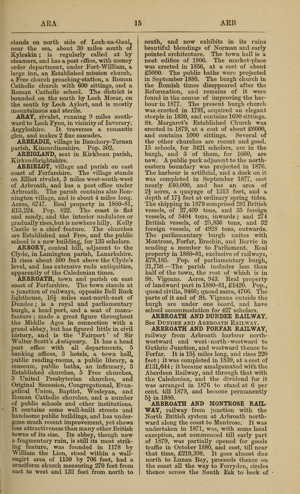page: 15 line: 39
ARBROATH, town and parish on east coast of Forfarshire. The town stands at a junction of railways, opposite Bell Rock lighthouse, 16^ miles east-north-east of Dundee ; is a royal and parliamentary burgh, a head port, and a seat of manufacture ; made a great figure throughout the Middle Ages in connection with a grand abbey, but has figured little in civil history, and is the ' Fairport ' of Sir Walter Scott's Antiquary. It has a head post office with all departments, 5 banking offices, 3 hotels, a town hall, public reading-rooms, a public library, a museum, public baths, an infirmary, 5 Established churches, 5 Free churches, 3 United Presbyterian churches, and Original Secession, Congregational, Evangelical Union, Baptist, Wesleyan, and Roman Catholic churches, and a number of public schools and other institutions. It contains some well-built streets and handsome public buildings, and has under-gone much recent improvement, yet shows less attractiveness than many other British towns of its size. Its abbey, though now a fragmentary ruin, is still its most striking feature, was founded in 1178 by William the Lion, stood within a wall-engirt area of 1150 by 706 feet, had a cruciform church measuring 270 feet from east to west and 132 feet from north to south, and now exhibits in its ruins beautiful blendings of Norman and early pointed architecture. The town hall is a neat edifice of 1806. The market-place was erected in 1856, at a cost of about 5000. The public baths were projected in September 1880. The burgh church in the Romish times disappeared after the Reformation, and remains of it were found in the course of improving the harbour in 1877. The present burgh church was erected in 1791, acquired an elegant steeple in 1830, and contains 1690 sittings. St. Margaret's Established Church was erected in 1879, at a cost of about 6000, and contains 1000 sittings. Several of the other churches are recent and good. 15 schools, for 3421 scholars, are in the burgh, and 3 of them, for 1660, are new. A public park adjacent to the north-eastern boundary was projected in 1876. The harbour is artificial, and a dock on it was completed in September 1877, cost nearly 40,000, and has an area of 2| acres, a quayage of 1313 feet, and a depth of 17J feet at ordinary spring tides. The shipping in 1879 comprised 281 British vessels, of 27,409 tons, and 35 foreign vessels, of 5404 tons, inwards ; and 274 British vessels, of 25,836 tons, and 32 foreign vessels, of 4928 tons, outwards. The parliamentary burgh unites with Montrose, Forfar, Brechin, and Bervie in sending a member to Parliament. Real property in 1880-81, exclusive of railways, 79,185. Pop. of parliamentary burgh, 21,758. The parish includes less than half of the town, the rest of which is in St. Vigeans. Acres, 943. Real property of landward part in 1880-81, 1420. Pop. , quoad civilia, 9466; quoad sacra, 4706. The parts of it and of St. Vigeans outside the burgh are under one board, and have school accommodation for 427 scholars.


